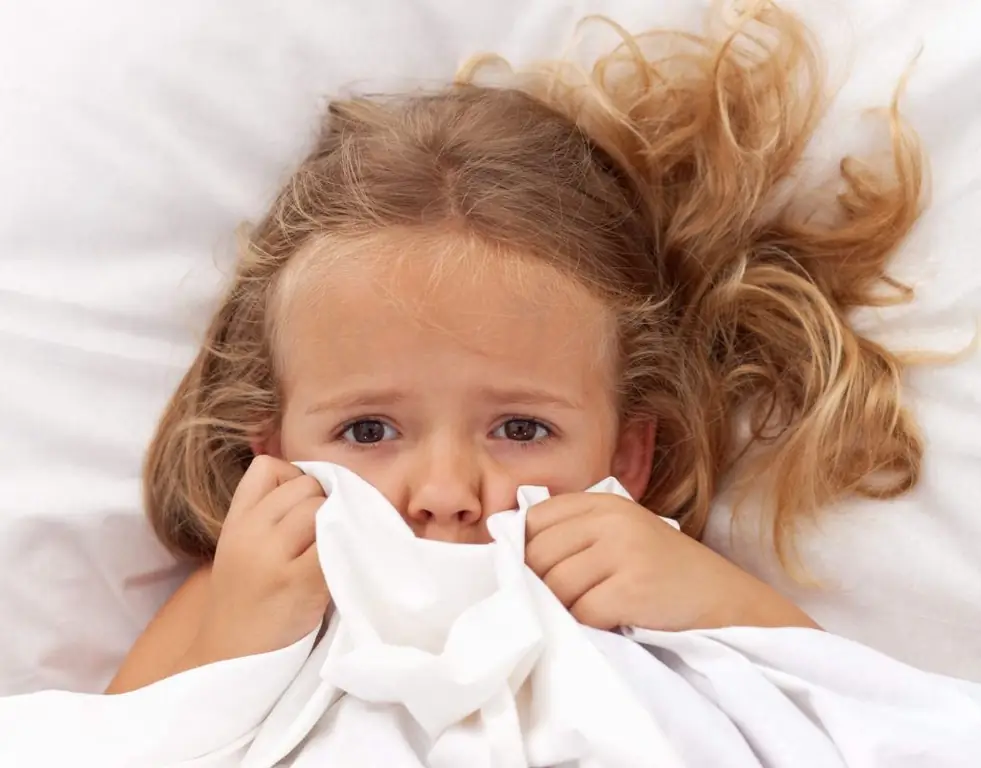2026 Author: Priscilla Miln | [email protected]. Last modified: 2025-01-22 17:55:29
Dysentery is an infectious disease caused by Shigella bacteria. These microorganisms are of several types: Shigella Sonne, Flesner and Grigorev-Shiga. The disease mainly affects the large intestine, and there is also a general intoxication of the body.

To prevent this disorder, you should know how dysentery manifests itself in a child. Symptoms of the infection, as well as its treatment and prevention - that's what this article will discuss.
Dysentery: causes in children
The bacteria that cause this disease are very resistant to various environmental factors. They can live and breed for a long time in water, on food, utensils, and generally stay in the soil for up to three months. The source of infection for children can be either a patient with dysentery, or a carrier of this infection. As soon as the child gets sick, he himself becomes the distributor of this infection. For infants, the source of the disease may be their mother. Dysentery in a child, the symptoms of which will be discussed a little later, may be caused by poorly developedhygiene skills, because it is not for nothing that this infection is called the disease of dirty hands. Perhaps that is why children become carriers of the disease much more often than adults.

Dysentery in a child: symptoms
The disease can have a different form - acute or chronic. The latent (incubation) period lasts from several hours to a week. But most often the disease manifests itself 2-3 days after infection. The child's body temperature rises, which can last up to three days, vomiting, dizziness, lethargy, headaches and loss of appetite may occur. But the main symptom of the disease is the presence of frequent loose stools, the number of trips to the toilet is from 5-6 times a day. Feces may contain impurities of green mucus and blood streaks. There is aching pain in the abdomen, which is cramping in nature, it may weaken after the child went to the potty.
How to treat dysentery in children
Treatment is prescribed, as a rule, depending on the form of the disease and its severity. In order to get rid of dysentery successfully and quickly, you should follow a special regimen and diet, which depends on how old the baby is.

In the first days after the onset of the disease, the amount of food should be reduced. Food must be steamed and finely rubbed. S alty, fatty and spicy foods should be excluded from the diet. With dysentery, rice water helps well, as it has an envelopingaction. With this disease, the body is severely dehydrated, so the child needs to drink plenty of water. You can give your baby water with saline glucose, it is also good to use decoctions of berries and vegetables, strong sweet tea with lemon.
Dysentery in children under one year: how to treat
Very small children after heavy drinking in the form of tea are given expressed milk, in its absence kefir or acidophilus. All complementary foods necessary for the baby are replaced with decoction or tea. If the child's he alth improves, then it can be gradually applied to the chest. If vomiting resumes, then breastfeeding is again reduced. It should be remembered that only the attending physician can prescribe all medications. If parents have suspicions that a child has developed dysentery, the symptoms of which are described above, they should seek medical help as soon as possible. As preventive measures, hygiene measures play a huge role: thorough washing of fruits and vegetables, hands before eating.
Recommended:
Auto-aggression in a child: causes, symptoms, diagnosis, treatment and prevention

Children's auto-aggression is called destructive actions directed by him at himself. These can be actions of a different nature - physical and psychological, conscious and unconscious - a feature of which is self-harm
Polycystic kidney disease in cats: treatment and prevention

Every owner wants his pet to live with him for a long time and be completely happy. First of all, for this he must be he althy. Kidney diseases are not at all uncommon among the Felines, so every owner should be aware of their signs and symptoms in order to contact the veterinarian in time. Today we will talk about what is polycystic kidney disease in cats
Night fears in a child: causes, symptoms, consultation with a psychologist and pediatrician, treatment and prevention of repeated fears

Night fears in a child are classified by experts as a widespread group of sleep disorders. Many parents have encountered their manifestation in their baby at least once in their lives. Most of all, children are afraid of bad dreams, darkness, the absence of their mother, and loneliness
Pinworms in a child: methods of treatment and prevention of the disease

If you suspect pinworms in a child, then you should not self-medicate, consult a doctor. Without consulting a specialist, you can only take preventive measures to prevent re-infection
Ferrets: diseases, possible causes, symptoms of the disease, treatment, prevention and advice from veterinarians

Recently, more and more often, fans of pets give birth to ferrets in houses and apartments. Animals are undemanding in content, mobile, intelligent and cheerful. And yet there are some nuances that you need to know if you are going to make such a friend. Despite strong immunity, there are a number of ferret diseases that attentive owners should be aware of

